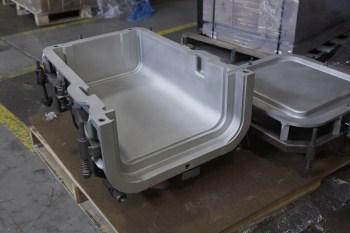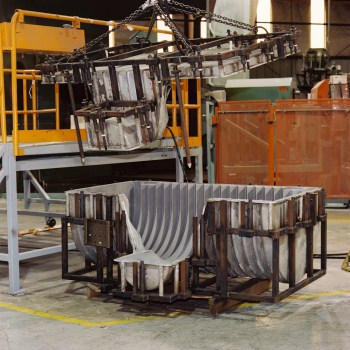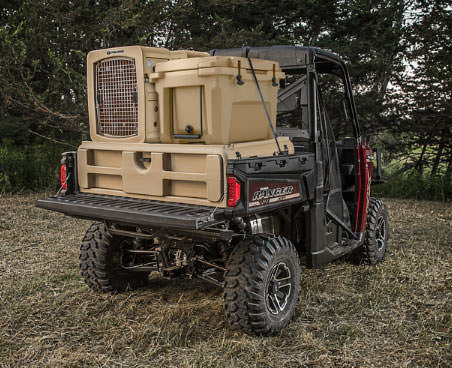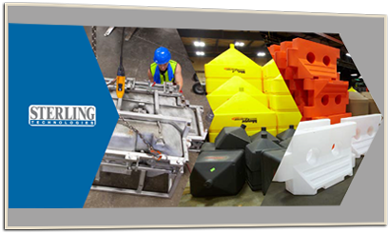814.774.2500
814.774.2500

 Rotational Molding
Rotational MoldingRotational molding is a versatile manufacturing option with many benefits over standard thermoform, injection and blow molding. This process makes it possible to design very large hollow pieces in virtually any shape, size, color and configuration. Generally, pieces are lightweight with strong structural integrity. 
The process uses a variety of mold types and molding machines that contain loading, heating and cooling areas. Once a mold is bolted to one of the machine’s rotating arms, the pre-measured plastic resin is loaded. Several molds on as many as three arms can be used at the same time. The molds then move into the oven and rotate on both the vertical and horizontal axis. The melting resin adheres to the mold and lays down a thick even coating, filling in areas that need more structure. The rotating continues during the cooling cycle where the part retains an even thickness.
Advantages of Rotational Molding
parts originally assembled from several pieces can be molded as one piece.
manufacturers can produce consistent, stress-free wall thickness and strong outside corners.
engineers can select the best materials and additives for their application making the parts weather resistant, flame retardant, or static free.
designers have the option of adding inserts, threads, handles, minor cuts and fine surface detail.
large and small parts can easily be produced. Since there is no internal core, minor changes can be made to existing molds making the process more cost effective. Parts are formed with heat and rotation, unlike injection molding, which requires high pressure.
material and production costs are lower because lightweight materials replace heavier and often more expensive materials.
manufacturers can get their product through prototyping and to market quickly.
| Plastic Molding Process Comparison Chart | |||||||||
|---|---|---|---|---|---|---|---|---|---|
| Molding Process | Process Description | Ideal Purposes | Low Mold Cost? | Low Unit Cost? | Quick Turn Around Time? | High Strength Parts? | Complex Part Geometries? | Pros | Cons |
| Injection Molding | Heated plastic is injected into mold | Creating small and/or critical tolerance parts | X | X | X | Quick turn around and very detailed parts | Weaker parts than other processes, very high upfront costs | ||
| Reaction Injection Molding | Plastic is injected into mold and cures from chemical reactions | Panels, enclosures, housings, automotive parts | X | X | X | Low mold costs, strong flexible parts | Long process times, expensive raw material costs | ||
| Blow Molding | A parison (tubular plastic charge) is attached to a mold and then filled with air. | Bottles, various containers | X | X | Fast, cheap production | Weaker parts, limited geometry | |||
| Vacuum Forming (vacuuforming) | Heated plastic sheet is stretched over mold and suctioned into the form. | Product packaging, speaker casings, car dashboards, aerospace | X | Flexibility in molding structures | Only adept at making shallow parts, processing can be difficult, limited geometry | ||||
| Compression Molding | Heated plastic charge is compressed to shape of the mold. | Automotive parts, textiles, large pattern pieces | X | X | X | Can mold large and intricate patterns, very low cost, Ultra large basic shape production | Poor product consistency, heavy flash issues | ||
| Extrusion | Heated plastic is forced through a die creating a long part | Tubing, piping, fiber optics | X | X | X | X | Low cost and quick turn around | VERY limited geometry | |
| Rotational Molding (Rotomolding) | Plastic charge is placed in a mold which rotates, bi-directionally, in oven | Containers, fuel cells, Large/complex products, housing, enclosures, concept products | X | X | X | X | X | Very strong, flexible, cheap parts. Several finishing and production options. Complex geometries are possible | Very small tolerances are difficult to form, slower than high-speed processes. |
| Thermoforming | Heated plastic sheet is stretched over mold | Disposable cups, containers, lids, trays, blisters, clamshells, vehicle door and dash panels, refrigerator liners, utility vehicle beds and pallets | X | Strong and flexible parts. | Slower processing and very difficult to form complex geometries | ||||
| Twin Sheet Foaming | Method of Thermoforming that welds two plastic sheets into one 3D product | Pallets, portable toilets, housings, tanks, air and ventilation ducts, enclosures, cases, toys, flat and transportation-related products | X | X | Stiff, more structural parts | Limited geometry, additional machines required for various materials, parts aren't as flexible | |||
| Selective Laser Sintering | Plastic material is heated with a laser until its particles adhere to each other | Concept or highly specific/critical tolerance designs | N/A | X | Useful for extremely critical dimensioned designs, no mold costs | Very high costs, slow process, size limitations | |||
| Rapid Prototyping | Photosensitive plastic is cured by a laser in layers | Concept design | N/A | X | Excellent for scaled down concept models. | Very expensive, fragile, cannot be easily modified, size restrictions | |||
| Lost Foam Casting (making molds) | Part is coated and pressed into sand. Metal (or other material) is poured into depression. | Making molds and duplicates of concept designs | N/A | Great for making molds and rarely duplicates of parts our of specific metal materials | Not useful for production and expensive | ||||

The rotational molding process uses biaxial rotation and high temperature to fill the mold and form the plastic part or component. The rotomolding process is ideal to produce large, hollow, one-piece parts.
Sterling Tech operates "Carousel" type rotational molding machines with at least 3 "arms" with multiple molds positioned on each. In its simplest form, one arm is being loaded and unloaded, one arm is rotating or spinning in a gas-fired oven molding the parts, and the third arm is being air or water cooled. Each arm may contain 2,4,7 up to 10 separate molds per process cycle. The rotomolding machine's arms move independently from one another allowing a variety of mold sizes with different receipts for heating and thickness.
Each part being molded has its own receipe for production. This includes the amount and formulation of the resin, rotation speed, oven temperature and processing or heating time. Cycle times can be long... often up to 30 minutes. With these longer cycle times, rotationally molded parts typically have run lengths range from just a couple to hundreds of parts with annual order quantities as low as 50 up to thousands of parts.

Ensuring proper product design is critical for manufacturing and assembly optimization as well as the general success of the product itself. Rotational molding designs and prototypes using 3D solid model rendering and rotolog tooling capability studies are used to help guide customers through the intricacies of the rotational molding process.
With pending ISO 9002 certification and drawing from techniques outlined in Six Sigma, World Class and Lean Manufacturing, Sterling Technologies is dedicated to delivering superior quality. Process controls include rotolog tooling capability studies to optimize product quality throughout the run.
Designing a Sound Rotationally Molded Component
The nominal wall... the frame of your product
The nominal wall is the basic frame of your product. It is the single most important aspect of your design and it must be handled correctly for quality assurance. The thickness of the nominal wall will not only determine its strength, but also its load bearing capability. The thickness will have a direct effect on the cost of your overall product. The ideal minimum thickness of .125 inches provides a good compromise between cycle time, processing ease, strength of product, and cost.
The rotational molding process permits a designer to change the wall thickness of their product after the mold has been built, tested and sampled. This versatility is not common in other plastic processing techniques.
Uniform wall thickness
The general nature of rotational molding allows the thickness of the wall to be even throughout the finished part. This gives designers more flexibility with product design, even with the most unusual shapes. Although designers have gone as low as .090-inch wall thickness, a safe .125-inch minimum should be adhered to.
Non-uniform wall thickness
Although rotational molding is known for its uniform wall thickness, non-uniform wall thickness can also be produced with some limitations. Several techniques are used successfully to produce items like vertical storage tanks with gradually thickening wall near the bottom where the weight limit is greater.
Flat surface limitations
Rotational molds are formed without internal cores, making it difficult to assure flat space on large panels. Many experienced designers are able to make adjustments in designs to accommodate the lack of flatness with the use of reinforced ribs, providing a .015 inch-per-inch crown on flat surfaces or using decoration or lettering to mask the curvature of the product.
Parallel wall separation
Due to the nature of rotational molding, it is important that sufficient space is left between parallel walls in a mold design. The liquid or powered plastic must be in contact with all surfaces of the cavity to ensure regular cooling times and preventing molded-in stress. Although a three times wall thickness separation is achievable, a four to five times wall thickness separation is recommended.
Requirements for corner angles
In addition to the space needed between parallel walls, corner angles must also be designed to ensure even wall thickness throughout an irregularly shaped part. Corners measuring 90 degrees or more require no special treatment. Anything under 90 degrees will require special attention and a closer look at the materials used for the process. Harder flow materials such as polycarbonate should not be used in a part requiring angles less than 45 degrees.
Draft angles for easy removal
Draft angles are tapers applied to the part making removal from the cavity easier. Draft angles reduce the force placed on a part during the removal and, therefore, minimizing cooling time, cost, induced stress, and part warpage. One advantage that rotational molding has over other molding forms is that many parts can be manufactured successfully without using draft angles. As the part cools, it shrinks away from the mold, making it easy to remove.
There are no specific rules for determining the use of draft angles. Certain materials such as polyethylene are used for softer pieces and can be removed without difficulty. However, the designer must take in consideration the materials used, shape of the part, and inside shrinking of the piece during the cooling process. When it does not interfere with the design, draft angles should be used liberally to ensure easy removal.
Designs using internal and external undercuts
An undercut on a rotationally molded part is any projecting wall that is parallel to the parting of the mold that must be deformed in order to be removed from the mold. Because of the rotational molding process there are design limitations and material requirements in order to produce an effective piece. Many times parts are constructed of two or more pieces to accommodate internal and external undercuts that are necessary for a product. These extra components, however, do add to overall maintenance and design costs.


Since the rotational process uses centrifugal force, not pressure, to fill the mold, rotational molds are relatively low cost when compared to other processes like injection and blow molding. It is important for customers to choose the correct rotational mold for their application. Each type of mold lends itself to different types of products.
The following is an overview of molds available for the plastic rotational molding process.
The most important thing to consider with all types of molding is the quality of the mold. There is no substitute for an excellent mold. A Production rotational molder can advise you on the type of mold best for your application, and the plastic material most suitable for your product. Sterling Technologies can help you make the right decisions to make your product stand out from the rest.

Removed from the rotational mold, parts are quickly transferred to finishing where the warm flash is trimmed, assembly holes are drilled and the part is staged for further operation or is wrapped for shipping. If desired, Sterling will "flame" the surface to create a smoother more glossy finish without affecting the quality of your rotationally molded part.
Additional graphic details can be added before or after the molding process. Mold-in-Graphics can be placed inside the mold's cavity prior to molding. These graphics can be large, colorful and will withstand continued use. Sterling Technologies also provides a range of other graphic enhances including hand painting! Sterling provides:

 Click on chart to view it at full size.
Click on chart to view it at full size. 
The Sterling Advantage reflects not only our rotational molding capabilities, but also the dedication and commitment of our team of rotational molders. Guided by process and quality controls the "Can-Do" team spirit ensures customers receive their parts as specified and on time. World class customer service provides constant production updates and open communication with customers. Team leaders from estimating, production scheduling, molding and finishing all work to provide streamlined communications and set proper expectations. The Sterling Advantage... providing leadership in custom rotationally molded plastic parts.
How does your involvement with customers generally begin?
Our involvements typically starts from the very beginning. The customer will contact our sales department to outline the project, and at that point they will set up a conference call or a face-to-face meeting to discuss the project.
Do customer typically submit a drawing right away, or is it just a concept idea?
That all depends on where they are at with their project. Some customers come to us with a fully designed product that we just have to redline to make sure if fits our molding process, others may come to us with a rough sketch of what they want, and some just have nothing at all and we have to start from scratch. I think that is what makes us unique is the fact that no matter where they are in the process we can help them get them product to the finish line.
What kinds of evaluations do you go through to be sure it is engineered properly for rotomolding?
There are a number of things we look for when designing and evaluating a project. We look for sharp corners or even very small radii, in rotomolding typically these type of areas like to trap air/gas bubbles which result in porous edges. Another area we look at is does the part have the proper draft built into it and are there any areas the create an undercut that would prevent the part from being able to be de-molded. We also review the model to make sure that there are no areas that are narrow and deep that may prevent heat transfer in the mold itself. Without heat transfer in the mold the plastic will not form in those areas. The last major thing we look for is the actual interior volume of the mold. There must be enough volume in the mold to accommodate the proper charge weight of the part. A general rule of thumb is 1 cu.ft. of interior volume can hold up to approx. 21 pounds of resin. The charge weight of a part dictates the wall thickness. The same mold can produce parts with different wall thicknesses just by increasing or decreasing the charge weight. So for example, if the part requires 42 lbs of resin to create a part with a wall thickness of 3/16" it would need approx. 2 cu.ft. of interior volume, but the mold only has 1.375 cu.ft. of interior volume. So it would not be able to produce a part with a 3/16" wall thickness. The customer would then have to do one of two things, increase the interior volume or decrease the wall thickness of the part. These are only some of the major things we look for, there could be some other areas that we find on occasionally that need to be modified.
Is there a typical timeframe that you try to adhere to? Two days, two weeks, two months?
Every project is different. It really depends to the scope of work. I have seen some jobs take a day to design and some have taken a lot longer.
Have you had conversations with clients about their experiences with other designers or molders? ...how does Sterling stack up... easy to work with, fast results, etc
I have not heard directly from the customers, but I have heard through other people that our turnaround time for a design is fast and our level of professionalism is top notch.
How involved are you with the actual mold design and specification?
Very involved. We layout how we want the mold to look and how they are to operate one they are complete. We create the complete list of specification for the tooling group.


Polaris is the leader in off-road, ATV and Utility vehicles for sportsman and outdoor enthusiasts. Hunters have been a strong and growing customer of their business. To capitalize on this market, Polaris looked to Sterling Technologies to help develop some products for their new line-up.
Scott S., Polaris Team Leader - Engineered Parts & Accessories, had a concept for a gun vault, dog kennel, and cooler package option for the bed of their popular Ranger™ UTV. After doing his research, he contacted Sterling Technologies to explain his vision, review the timeline of project and discuss consumer price points. Within one month, Scott had his final drawings and ordered his tooling through Sterling's OneSource FastTrack program. The tool was online, molding sample quantities just 3 months from that initial phone call.
Scott S., Polaris Team Leader - Engineered Parts & Accessories
"Working with the Sterling team from sales through production was a terrific experience. They helped us develop a high-quality, modular system all while helping us maintain desired margins. Our company has a strong reputation for product quality and value and that's what was delivered. I'm sure this is just the beginning of our partnership with Sterling."
This guide covers an overview of plastic rotational molding, critical design considerations for rotationally molded parts, rotational molding tooling, mold-in-graphic, typical projects and much more.
